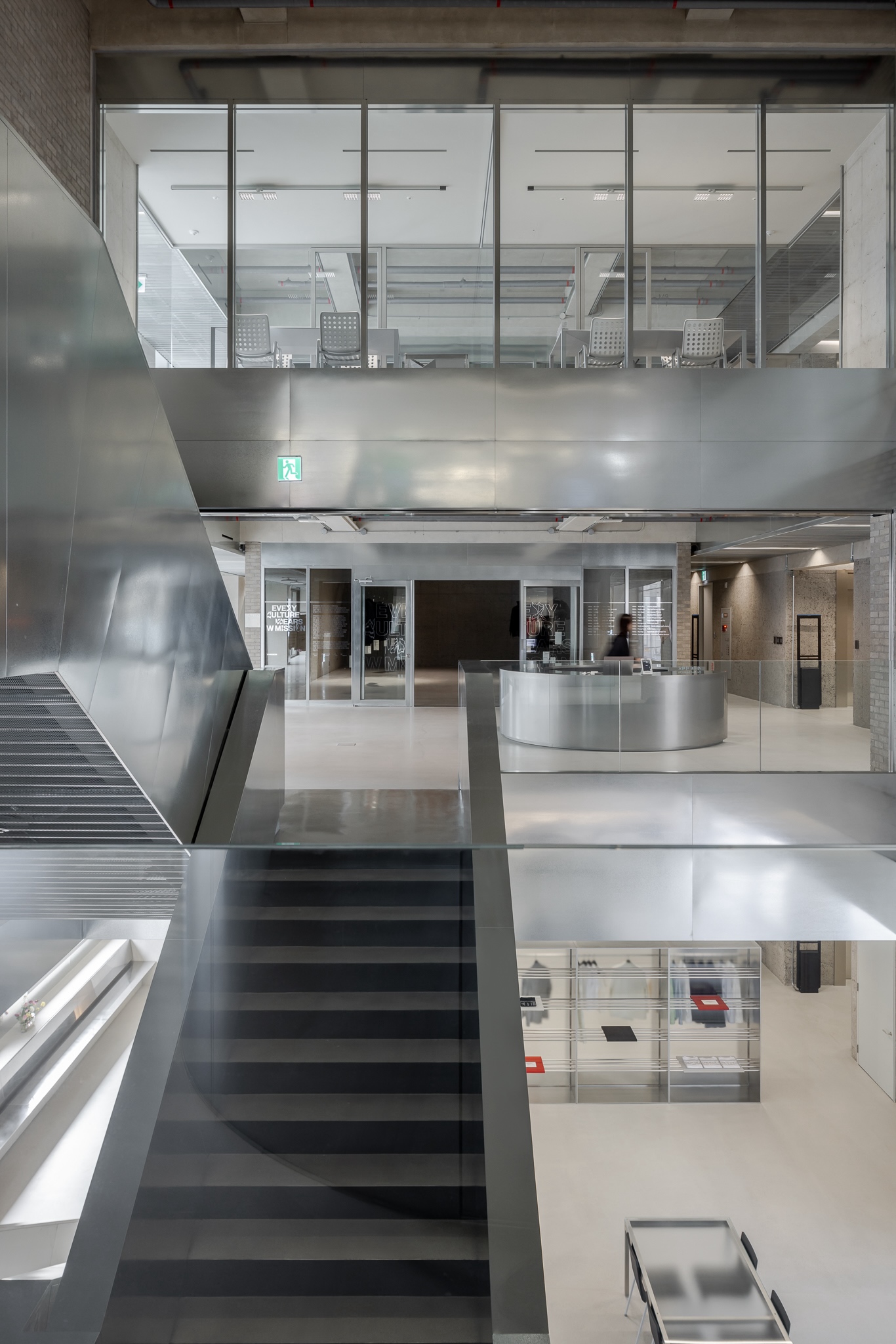W-Mission為韓國紡織品製造商,此設計委託案由三個業主最關心的主題出發:神聖性、庇護所、社區的連結性。靈感來自業主的成長背景,一個被海洋圍繞的小鎮,以及紡織品材料特性,包含輕盈、編織、起伏和遮掩性;立面上亦將傳統哥德式建築的尖肋拱頂,由大教堂的內部翻轉到都市街道上,強調建築作為神聖庇護所的社區責任與特性。如同在德國西北紡織商會大樓設計研究過程中我們所理解到的,在雕塑藝術史上以石材呈現如布料般柔軟的褶皺一直是一種迷人的悖論;若將此應用在建築上,傳統的砌磚工藝也能編織出一道柔美滑順的曲牆。韓國磚造建築擁有悠久的歷史,而在本案中採用的方式為「帷幕牆」系統,紅磚透過弧形金屬構件依附於場鑄的曲面混凝土牆上,建構出如帷幕般的牆面。我們透過數位軟體模擬計算曲面,實現向著天際漸變的波浪效果;在共計疊有五百二十層磚的牆面上,每二十四層會被加入一塊新磚,使曲線增長,而波幅始於第三層樓高的零厘米,一直到屋頂的一百七十厘米。
該建築由三個機能垂直分層組成:
- 社區空間位於臨街道的前方,包括WM咖啡廳、花園、W-Mission紡織學院等等;由三層樓高的挑高中庭構成了建築的核心公共空間。
- 共計四層的開放式辦公區座落於公共空間之上。
- W-Mission的企業位於建築頂部三層樓。包括辦公室、工作坊和聚會空間。在此區域中,由巴西利卡式中殿所啟發的雙層連通空間引入自然光,營造出沈靜的氛圍。
- 這三個區域都擁有半戶外的雙層庭院;寬敞的戶外空間和內部的中庭相互組合形成垂直鄰里,彼此錯開但同時相互連接,由建築延伸至室外和天空,加強了社區感。由首爾森林公園對側至聖水洞街道西邊,波浪狀的立面成為都市的背景。獨特的紅磚立面同時容納服務空間和垂直動線;東向立面的室外花園和露台坐擁漢江水景和聖水洞開放視野;北向立面由三種尺寸的小開口組成,看似隨機分佈但實則滿足了各空間機能的採光需求。
W-Mission is one of the highest quality textile manufacturers in South Korea. Their new headquarters are located in Seongsu-dong, Seoul, known for their shoes manufacturing factory buildings built with traditional red brick. This reborn district has become a vibrant urban landmark for art, culture and design in the Korean capital.
The commission of this design departs from three main existential concepts that best represent the spiritual character of the client, sacredness, sanctuary and community. The inspiration for it reflects on the ocean waves of the birthplace of our client and the material properties of textiles, such as lightness, weaving patterns, undulation and enclosure as well as disclosure. The architectural features heighten the feeling of spirituality; the main one being the reversal of a traditional gothic high arched facade from the interior (of a cathedral) to the exterior urban street.
The reproduction of drapery in stone sculpture, as researched during the design process of the Administrative Building for the Textilverband, has always represented a captivating paradox. In this case, the traditional brick masonry system offered great capacity to depict and adapt to the desired curve. Brick construction has a long historical tradition in Seoul. The adopted solution in this case is a literal ‘curtain wall’ system using bricks, attached to a concrete wall cast “in situ” that serves as a guide to construct the curve. With the help of a digital computational tool, we could devise a rather simple algorithm for creating the intended wave effect rising up to the sky. With 520 courses of brick height, every 24 courses a new brick is added to achieve the desired curve growth. The wave amplitude ranges from 0 on the third floor where it starts, to 170cm at the roof line.
The building consists of 3 stratified programmatic layers:
- The community zone with street frontage, that consists of the WM Café and garden, the WMission academy, workshop and exhibition spaces. A three-floor height atrium articulates the public program of the building.
- An open office block of four floors is located above the public package.
- W-Mission’s headquarters as top zone on the last three floors. Integrated by office program, workshop and gathering spaces. Within this private area of the building, double height interconnected spaces inspired by the typology of the basilica nave introduce natural light that evokes an environment for spirituality and meditation.
- All 3 zones offer semi-outdoor double height courtyards. Put together, the building creates a kind of vertical neighborhood with generous outdoor pockets and internal patios that are shifted but interconnected, all reaching out to the outdoor space and the sky and reinforcing the feeling of community.
The waving façade acts as a backcloth for the urban perspectives of the streets that lead into Seongsu-dong District from the west across the Seoul Forest Park. This characteristic solid façade houses the service program and the vertical circulations, while the outdoor gardens and terraces on the east façade offer a wide-open view towards the Han River and Seongsu-dong District. The north façade is composed by apparently random openings categorized by three different types that respond to programmatic requirements of the space.


